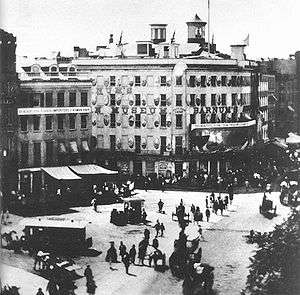Barnum's American Museum

Barnum's American Museum was located at the corner of Broadway and Ann Street in New York City, USA, from 1841 to 1865. The museum was owned by famous showman P. T. Barnum, who purchased Scudder's American Museum in 1841. The museum offered both strange and educational attractions. It burned to the ground in 1865. The museum is also referenced in the broadway musical Barnum. It was relaunched on the Internet in July 2000.[1]
History
In 1841 Barnum bought Scudder's American Museum across from St. Paul's at the corner of Broadway and Ann Street. He converted the five-story exterior into an advertisement lit with limelight. The museum opened on January 1, 1842.[2] Its attractions made it a combination zoo, museum, lecture hall, wax museum, theater and freak show, that was, at the same time, a central site in the development of American popular culture. Barnum filled the American Museum with dioramas, panoramas, “cosmoramas,” scientific instruments, modern appliances, a flea circus, a loom run by a dog, the trunk of a tree under which Jesus’ disciples sat, a hat worn by Ulysses S. Grant, an oyster bar, a rifle range, waxworks, glass blowers, taxidermists, phrenologists, pretty-baby contests, Ned the learned seal, the Feejee Mermaid (a mummified monkey’s torso with a fish’s tail), midgets, Chang and Eng the Siamese twins, a menagerie of exotic animals that included beluga whales in an aquarium, giants, Grizzly Adams’s trained bears and performances ranging from magicians, ventriloquists and blackface minstrels to adaptations of biblical tales and “Uncle Tom’s Cabin.”
At its peak, the museum was open fifteen hours a day and had as many as 15,000 visitors a day.[1] Some 38 million customers paid the 25 cents admission to attend the museum between 1841 and 1865. The total population of the United States in 1860 was under 32 million.
On July 13, 1865 the American Museum burned to the ground in one of the most spectacular fires New York has ever seen.[3] Animals at the museum were seen jumping from the burning building, only to be shot by police officers. Barnum tried to open another museum soon after that, but that also burned down in a mysterious fire in 1868.[4] It was after this time that Barnum moved on to politics and the circus industry.[5] Barnum's American Museum was one of the most popular attractions of its time.[6]
In July 2000 a virtual museum version opened on the Internet, supported by a grant from the National Endowment for the Humanities. The CUNY Graduate Center rebuilt the five-story museum on a Web site with the aim to provide students and history buffs with a full archive of information about the museum and relevant 19th-century subjects.[1]
Attractions
_of_Barnum's_American_Museum%2C_New_York_City_-_jpg_version.jpg)
The museum's collection included items collected throughout the world over a period of 25 years.[7] The museum offered many attractions which grew to great fame. One of the most famous was General Tom Thumb a 25-inch tall dwarf. Thumb wasn't the only physical oddity there, there was also the Fiji Mermaid and Josephine Boisdechene, who had a large beard, which had grown to the length of two inches when she was only eight years old. As if to supplement Tom Thumb, another famous attraction of the museum was William Henry Johnson, who was one of Barnum's longest running attractions. Another one of the famous attractions at the museum were Chang and Eng, Siamese twins who were extremely argumentative, both with each other and Barnum himself.
The museum also boasted an elegant theatre, called the "Lecture Room," and characterized in the popular Gleason's Pictorial Drawing-Room Companion of 1853, "one of the most elegant and recherche halls of its class to be found anywhere," which would offer "every species of entertainment" "'from grave to gay, from lively to severe,' and "judiciously purged of every semblance of immorality."[8]
At one point, Barnum noticed that people were lingering too long at his exhibits. He posted signs indicating "This Way to the Egress". Not knowing that "Egress" was another word for "Exit", people followed the signs to what they assumed was a fascinating exhibit — and ended up outside.[9]
The five story building also served great educational value. Aside from the different attractions, the Museum also promoted educational ends, including natural history in its menageries, aquarium (which featured a large white whale), and taxidermy exhibits; history in its paintings, wax figures, and memorabilia; and temperance reform and Shakespearean dramas in the above described "Lecture Room" or theater.[3]
See also
- Barnum Museum – completed in 1893 in Bridgeport, Connecticut
References
- 1 2 3 Tina Kelley (2000-07-01). "A Museum to Visit from an Armchair". The New York Times. Retrieved 2008-04-03.
- ↑ Darice Bailer (2001-01-21). "The View From/Bridgeport; Museum Invites Visitors to Step Right Up". The New York Times. Retrieved 2008-04-03.
- 1 2 "Disastrous Fire" (PDF). The New York Times. 1865-07-14. Retrieved 2008-04-03.
- ↑ "CIty and Suburban News". The New York Times. 1885-10-26. Retrieved 2008-04-03.
- ↑ Michael Frank (2002-06-21). "Will Wonders Never Cease?". The New York Times. Retrieved 2008-04-03.
- ↑ "The Barnum's American Museum Illustrated". Barnum's American Museum Illustrated Magazine. 1850. Archived from the original on 29 March 2008. Retrieved 2008-04-03.
- ↑ Brainerd Dyer (1958-07-13). "Today in History". The Los Angeles Times. Retrieved 2008-04-03.
- ↑ Gleason's Pictorial Drawing-Room Companion,, (New York), 1853-01-22, p. 73.
- ↑ O'Neill, Laurie (1981-12-27). "Almanac Is Itself a Rare Occurrence". New York Times.
External links
| Wikimedia Commons has media related to Barnum's American Museum. |
- The Lost Museum – Online version of the museum, published in the year 2000.
Coordinates: 40°42′40″N 74°00′31″W / 40.7112°N 74.0086°W